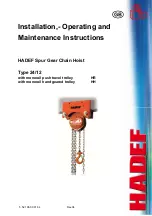
2
General safety notes
12
07.2020
ba
-o
.2
.6
.0
-us
-3
.2
-ys
|
A1
18
67
50
1 Re
v A
E
2.2
Inappropriate use
•
Use in areas with potentially explosive atmosphere.
•
Transporting molten metal.
•
Exceeding the maximum working load.
•
Transporting persons.
•
Pulling/towing or raising/lowering of a guided load.
•
Using the hoist in applications in which the working load changes with the position of
the load, as the hoist is not equipped with a load display and additional warning
device when it cuts off at overload.
•
Breaking away, pulling or towing of loads.
•
Use of rope drive for “guided loads” without being designed for this type of
application.
•
Breaking away of tilted loads if the rope drive is designed for the “guided load”
application.
•
Pulling loads at an angle, dragging loads or moving vehicles with the load or load
suspension equipment.
•
Do not knot load ropes or chains or shorten them with devices such as bolts, screws
or similar.
•
Removing the safety latch from suspension and load hooks.
•
Manipulating the overload safety device.
•
Operation with slack rope (loose windings on the rope drum).
•
If the product forms “part of a machine”, the person
placing it on the market must
ensure that the product meets the specific regulations of the application.
•
Application of external torques due to forces that are exercised from outside the
system, e.g. with gripper operation or through tilting/bumping of the load, in particular
with the option 4×90° hook locking.
2.3
Residual hazards
The machine has been subjected to a risk analysis. The design and construction based
on this correspond to the state of the art. However, residual hazards remain during
operation and maintenance and these could result in serious or even fatal injuries to
personnel.
•
Risk of crushing
•
Hazard due to falling parts (attached to the load or on the load)
•
Load toppling due to unsuitable or damaged load-bearing equipment
•
Risk of electric shock
Preventative measures:
1.
Use LOTO (Lockout/Tagout) procedure in accordance to national, state and local
regulations and company policy.
2.
Switch the machine off and ensure it cannot be switched on again before carrying out
maintenance, cleaning and repair work.
3.
Switch off the power supply before all work on the electrical system. Check that the
components to be replaced are free of current and voltage.
4.
Do not remove any safety devices or override them by manipulating them.
5.
When lifting or lowering loads ensure that no-one is in the immediate danger area.
6.
It is forbidden for anyone to stand in the danger area.






































